
“Playing guitar is easy, just follow the dots!” Playing the guitar is that easy, huh? I guess that explains why my grandma shreds like Steve Vai, right? I guess that’s why nobody rage quits daily…
There may be some truth to that “dot” statement, but we can’t always follow the dots these days. Sometimes we have to follow the diamonds, vampire bats, roses and thorns, and even the solar system planets.
What’s the deal with all these markers on my fretboard, anyhow? Why do they look like they do? Why are they spaced out as they are? What purpose do they serve?
What materials are inlays made out of? How do I use them? Let’s check out the history of classical guitar fretboard inlays from the past right on up to the present day custom inlays and stickers.
By the time we’re done, you’ll have a handle on all of the types available and how they work. Using them might take a little practice but what else are you doing, you guitar freak!
Put your thinking cap on because we’re going to start with a little music theory in our grand discussion on…
What are Guitar Inlays?
Guitar fret inlays are the markers along the neck of the guitar, usually circular dots, that serve as a visual aid so you can guide your hand to the notes you intend on playing.
Here’s an easier answer for beginners: “They tell you which fret you’re playing when you look down at your neck.”
Did you ever notice that the inlays are mainly on the odd numbered frets?
There’s a reason for that, too. Because the guitar is capable of playing chords, there needs to be a quick reference for the bass notes that you are stacking notes on top of.
It turns out that the natural notes of the C Major Scale lie along the open E strings on all of the inlays, which are the odd numbered frets. The only exception to this rule is the 9th fret, which explains why banjos tend to have a 10th fret inlay instead.
That’s where the “follow the dots” reference originated.
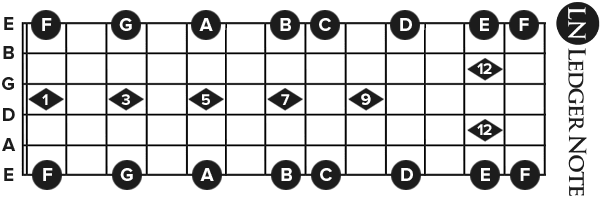
Another reason the frets are so important is they help to define hand positions while playing the instrument. Your hand will typically cover four to five frets at a time.
Any position you play in will encompass two inlays, and when you hit the third one, you know you the following note in sequence is available on the next string up instead. It’s an interesting design, and a unique way of interfacing with music, if you ask me.
That double dot 12th fret inlay might be the most important of all of them. There are 12 notes in the chromatic scale (this includes flats / sharps) before you find yourself repeating the original note an octave higher.
For those of you who don’t know what an octave is, it means you ran all the way thru your scale and found yourself back at the beginning at the first note, but at a higher pitch. The guitar has a mathematical principle that can be used based on the octave.
Let’s say you are shredding a solo in the open position E Minor Pentatonic scale and are running out of ideas and need to kick your sweet lead melodies into hyperdrive. All you gotta do is scoot up the neck 12 frets and all your hot licks are boosted up an octave and sound fresh and more intense!
The math is as simple as this: Add 12 frets to your current position and keep shredding!
That’s a simple breakdown of some of the common ways fret inlays are used and why they are on the guitar in the first place, other than making you look cooler with some of the modern styles.
Guitar Inlay Material
Inlays are mainly made of a handful of materials:
- Clay
- Shells
- Wood
- Plastic
- Gemstones
- Stickers
- Luminlay
These are the main top-level categories, but the names you’ll hear reside within them. Let’s look at what needs to be said about each one real fast.
You’ll see clay simply called “clay,” but it’s really a polymer mixed with clay for strength and resistance to impact and humidity. There are two types of marine life shells used for inlays called nacre and abalone.
You’ll see nacre called “Mother of Pearl” in white, black, and gold varieties. There’s also the rare use of gemstones of all types, but they are more commonly replicated using plastic.
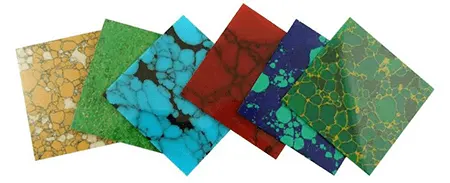
There are tons of types of plastic used, like celluloid, that are used to mimic other materials. You’ll find “Perloid,” which is a knock-off version of mother of pearl.
You’ll see swirled plastic to recreate every type of gemstone out there. You’ll also find Abalam, which is shaved and binded strips of abalone.
Finally, there are a ton of stickers out there that get the job done at a cheaper rate. The newest innovation is by a company called Luminlay that produces a phosphorescent fluorescent plastic that glows in the dark.
This isn’t for the crowd, but for the player on stage who can’t see his inlay fret markers well. You can charge them with a pocket, battery powered LED bulb in between songs and sets.
Historic Inlay Types
Inlays on the modern guitar find their roots, once again, in the historic companies of Fender and Gibson. These two companies, while not the very first electric guitar producers, often defined the standards by which all other guitars are compared.
Dots
The inlaid position markers on a Fender Stratocaster are one of the defining characteristics of the instrument. Not only do they have importance in playing the guitar, they also have historical components that lend to dating your strat.
Starting in 1954 with the introduction of the famous icon, the inlays have always been at the 3rd, 5th, 7th, 9th, 12th, 15th, 17th, 19th, and 21st frets.
It’s the inlay material and spacing with the strings that becomes a defining detail. While minute variants have occurred, they have become part of the guitar lore for more discerning guitar historians.

Stratocasters were originally only made with maple fretboards that used black dots to define positions. From 1954 to 1959, these black dots were almost perfectly aligned with the A and B strings at the 12th fret. That’s a sure fire way to know you have an original vintage strat.
In 1959, the rosewood fretboard was introduced, along with new matte white dots that are commonly referred to as “Clay Dots.” These maintained the same vintage 12th fret spacing as the original maple black dots.
It wasn’t until mid 1963 that both the maple black dots and the rosewood clay dots became inlaid closer together. For those tricky dating years, you can use the dot spacing to know if your axe is pre or post dot change.
After 1963, the rosewood clay dots were replaced with a material called pearloid that looked like mother of pearl, but was much cheaper to produce in higher quantity. This change was preserved until 1983.
In 1970, Fender began offering the maple fretboard with larger black dots. They were just a wee bit bigger than the originals, but are an important feature when researching vintage strats. These minor details are often missed in forgeries and fake vintages.
For some reason after 1983, Fender started putting in white plastic dots in rosewood fretboard models, foregoing the sparkle of the pearloid. This was halfway thru the year, so it offers up another great dating hallmark for collectors and historians.
Knowing this also helps the player to define the difference between a true vintage and a vintage reissue. Even Fender themselves decided to not use these important details when making copies of the originals.
Trapezoid & Blocks
Even though Gibson included the dot inlay on many versions of its classic designs, from the ES-335 to the SG and Les Paul, the company is known for its Trapezoid and Block inlays.
Not only did the inlays scream “fancier than Fender,” they also required the luthier to make more difficult cuts with the scroll saw, which involved more time and precision.
These inlays helped make Gibson’s high class image, as well as justify the higher price tag of their guitars. Gibson provided these images in an older feature (no longer online) regarding their fingerboard guitar inlays.

Instead of clay and plastic, Gibson used “mother of pearl” as inlay materials. Often times this was a fancy celluloid material, but the bright wavy appearance looks just like a pearl’s innards.
Their dots, above, are fancy indeed. This is what you see on most of the best beginner guitars still to this day, due to the emphasis on functionality and ease of visual sighting.

The trapezoid inlays above were most often found on Les Paul Standards and was never placed at the first fret. That revered inlay spot was saved for the ultimate in Les Paul technology: The Les Paul Custom. You can see that with a block inlay pictured below.

Very few Gibson models sported the highest quality inlays the company offered. The Les Paul Supreme needed a few delicacies to sweeten the pot, and the one with the most visual appeal is certainly the Gibson split-block inlays.

These are only reserved for the finest instruments the company offers.
Tree of Life
Ibanez is hands down the company to embrace and make famous the extra classy “Tree of Life” inlay scheme. Used often in the 60’s Lawsuit Era models, the Tree of Life signified that a top notch instrument was being played.
This was the era in which Ibanez was making copies of Rickenbacker, Fender, and Gibson models, but the company had many original statements to make, as seen in these classic inlay designs.

Many older Ibanez models featured this distinctive inlay design and even Bob Weir of the Grateful Dead had a model featuring it. These days, the “Tree of Life” is synonymous with the shred wizard Steve Vai, who’s famous JEM guitar series (seen above) helped to redefine acrobatic guitar stunts and bring this inlay pattern into the modern era.
Modern Guitar Inlays
During the 80’s, when extreme guitar technique was in its heyday, players needed that extra bit of flash to go along with their high flying shred skills. This era spawned many unique inlays that were often aggressive and fit the sharper curves and angular sounds the players were dishing out.
Sharkfin Inlays
I immediately think of Jackson guitars and their distinctive shark fin inlays when I think of 80’s hair metal guitarists. Jackson even offered these inlays as reverse shark fins, for those daring enough! Other models featured giant fins that stretched across the entire fretboard width.
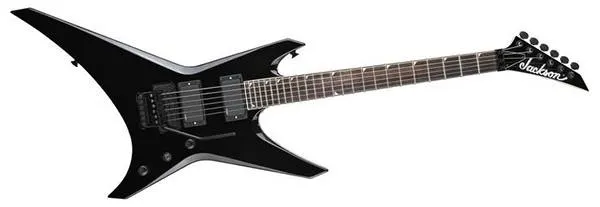
This inlay pattern was so popular, Jackson offered plenty of variants in materials and sizes to suit any shredders needs, from abalone, pearloid, and alumiloid to larger and small shark fins. You’ll see these and all types of other shapes on the best guitars for metal nowadays.
Neoclassical
Neoclassical fretboards use no inlays at all. While that sounds boring, some players prefer the sleek look of a clean fretboard. Most neoclassical fretboards still include the side dots, for the players convenience.
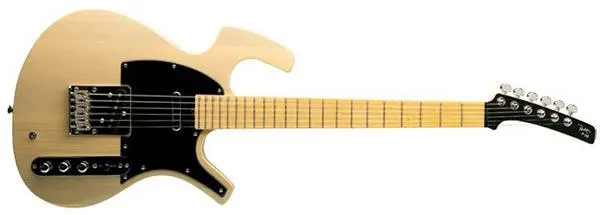
Above is the inlay-less Parker P-36.
Custom Inlays & Stickers
After this long discussion, you may be thinking that inlays are only for the fretboard or side of the neck, but that’s not the case.
The progression is where people began commissioning custom inlays along the fretboard, including space and science-fiction landscapes, dragons, Japanese cherry blossoms, and anything else you can imagine.
Guitar companies were already creating inlays to place their logos in the headstock, so it’s no surprise that we soon began seeing inlays on the body, whether that be the front, back, sides, and around the sound hole.
This extended all the way to inlays in the pickguards, bindings, more extravagantly on the side of the neck, in the purfling, and pretty much any where else it could be squeezed in.
Of course, as access to guitars and amplifiers became cheaper, so did the methods of customization. There are entire companies in existence who do nothing but produce high quality inlay stickers so everyone can get involved without having to hire or become a luthier.
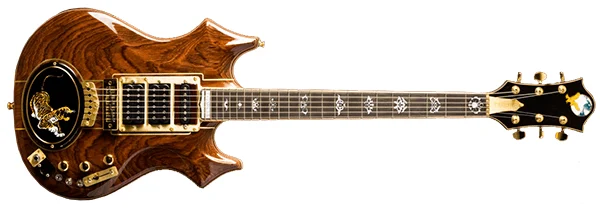
To show you a quintessential example of custom inlay work, we’ve included the Tiger Tribute guitar above, by Phil Gawen.
Guitar Inlays are Cool & Functional
Inlays have gone thru many variations, even before guitars existed! Seriously, check out any pre-guitar instrument such as lutes and ouds and you’ll see what I mean. The Renaissance era had many beautiful inlays that were precision crafted by luthiers of the past.
Today we covered the modern electric guitar era, but the history of the guitar inlay runs deep into times past. It’s a fun adventure if you have the time. Otherwise, keep learning more about playing guitar!